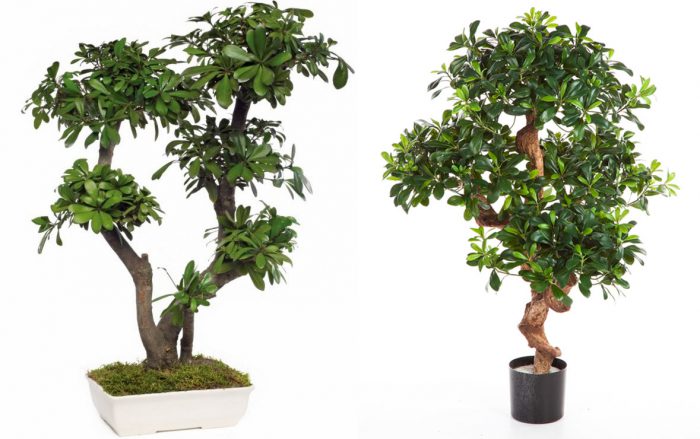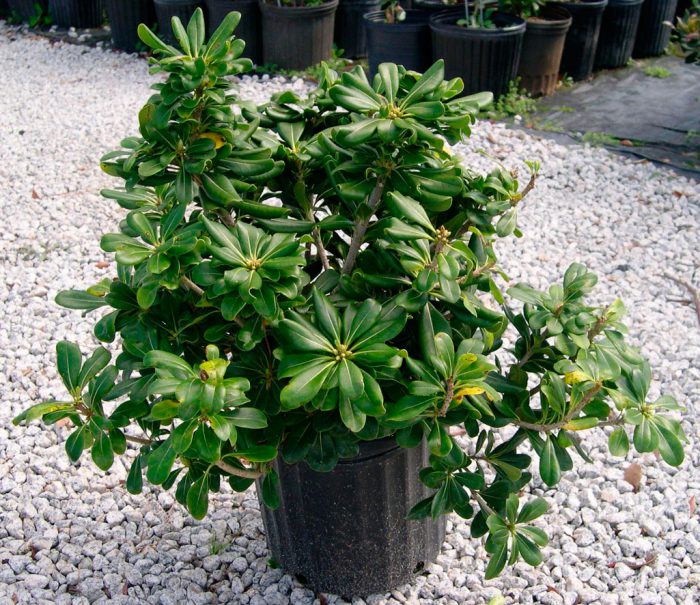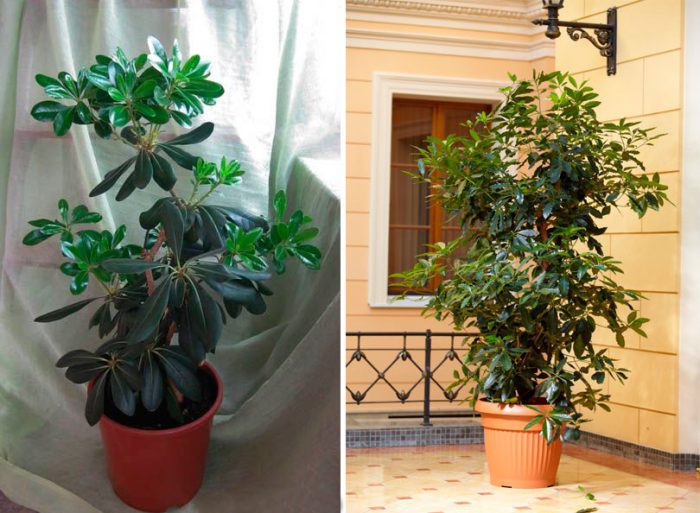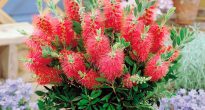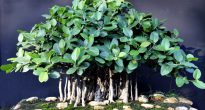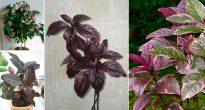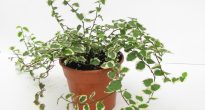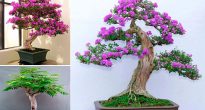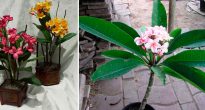Smolosemyannik or pittosporum (Pittosporum) is a genus that unites a large number of different plant species and is directly related to the resin seed family (Pittosporaceae). In nature, they are found in the subtropical and tropical zones of East Asia, Oceania, Australia, as well as in several regions of Africa.
This genus unites more than 150 species of various plants. The most popular of these is Pittosporum tobira. These plants were initially grown as a garden culture, but then they began to grow as a home plant.
Pittosporum Tobira is a rather low tree, reaching a height of no more than 6 meters, it is bushy and strongly branching. The internodes on the shoots are rather short, and the crown is flat. Spirally arranged simple, leathery leaves have rather short petioles. They reach 10 centimeters in length and 4 centimeters in width. The leaf has an elongated obovate shape, its front side is dark green, shiny, with a well-distinguishable lemon-yellow vein and petiole. With age, all leaves fall off from the bottom of the shoots, and they remain only at their tips. As a result, the bush becomes like a fluffy bunch.
Abundant flowering is observed in spring. Flowers appear in the axils of the leaves at the apices of the stems. They are white, have 5 petals, and reach 3 centimeters in diameter. Flowers are collected in small inflorescences. In place of the flowers, over time, green fruits appear, having the shape of a ball. In them, sufficiently large seeds ripen, which are covered with a resinous, very sticky substance. When the fruits are fully ripe, the dried capsules crack and open, but the seeds do not fall out, but remain inside for a long time.
This species has several varieties, as well as varieties. A variety with variegated leaves "Variegata" has also been bred, in which a whitish uneven border runs along the edge of the leaf plate.
Content
Caring for resin seeds at home
This plant is quite undemanding to care for, but at the same time it should be provided with special conditions of detention.
Illumination
This plant in the wild is very fond of light, and when kept at home, it must be shaded from the direct rays of the sun.When choosing a place to place a tree, it should be borne in mind that if there is not enough light, then all the foliage may fall. And if there is too much of it, then the leaves will change their direction to vertical, and this will destroy the unusual flat shape of the crown.
In winter, the tree should also be fairly well lit, therefore supplementary phytolamps are recommended for it. Daylight hours during this period should be approximately 13 hours.
Temperature regime
In the warm season, the air temperature in the room where the resin seed plant is located should be from 18 to 22 degrees. This tree reacts negatively to heat. In winter, the plant has a dormant period, and therefore it is recommended to lower the temperature to 7-10 degrees.
How to water
Can tolerate short-term droughts. Watering should be moderate. So, it is produced only after the top layer of the substrate dries out to a two- or three-centimeter depth. During cold wintering, watering is necessary less often. Between watering, the substrate must dry out to half. The resin seed plant reacts extremely negatively to overflow. So, rot quickly develops on its root system and the plant dies.
Humidity
In winter, when the air in apartments is dried by heating devices, and also on hot summer days, it is recommended to moisten the foliage using a spray. To do this, use lukewarm and necessarily boiled water so that whitish stains do not appear on the surface of the dark foliage. At other times, it is not necessary to spray the plant, but for hygienic purposes, it must periodically arrange a warm shower.
Pruning
In spring, it is recommended to carry out formative pruning without fail. The rest of the time, it is necessary to pinch young stems. An adult plant is especially in need of formative pruning, after leaves from the lower parts of the stems begin to fall off.
Also, very often, a special wire frame is used to form the crown. The branches of the resin seed plant are flexible enough to set the desired direction easily.
Earth mix
Suitable soil should be slightly acidic and rich in nutrients. And also it must pass air and water well. To create a suitable soil mixture, it is necessary to combine sod and leafy soil, as well as sand, taken in equal proportions. Do not forget to make a good drainage layer that can prevent stagnation of liquid in the substrate, which is the cause of the development of rot and death of the plant (especially during cold wintering).
Fertilizer
The resin seed should be fed during the period of its intensive growth 2 times a month. For this, both organic and mineral fertilizers are used, feeding the plant with them in turn. You can also use a universal fertilizer intended for indoor plants for feeding (using the dose recommended on the package).
Transplant features
Young plants should be replanted once a year, changing the flower pot to a larger one. The resin seed does not like this procedure and slow growth becomes his reaction to it. Since the tree takes root for a very long time, it is recommended to carefully roll it over, while trying not to damage the earthen lump.
Adult specimens are transplanted not so often, and in very large plants, you just need to regularly replace the top layer of the substrate.
Reproduction methods
Can be propagated by semi-lignified cuttings and seeds. The apical parts of the stems are cut into cuttings, and their length should be about 10 centimeters. Before planting in vermiculite or coarse sand, it is necessary to process the cuttings with a special root growth stimulator. Rooting takes place, as a rule, after 4 weeks. Such plants begin to bloom only after 5 or 6 years.
This plant is much more difficult to propagate by seeds.So, with insufficient experience, seedlings can be completely destroyed. And even in the early years, the plants hardly grow. In this regard, the resin seed plant is propagated in this way only if it is necessary to obtain a multitude of young plants.
Pests and diseases
Resistant to pests. When the humidity is too low, it settles spider mite... In this case, the plant needs to arrange a warm shower, and large specimens should be treated with special insecticides.
As a rule, the tree gets sick in case of improper care. In bright light, the leaves become faded and then turn yellow. If there is little light, then the leaves become monochromatic, and the stems become elongated. Reacts extremely negatively to overflow.

